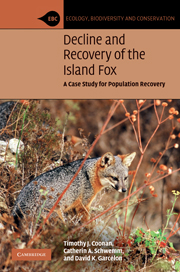Book contents
- Frontmatter
- Contents
- Foreword
- Acknowledgments
- 1 Introduction
- 2 Evolution and genetics
- 3 Social structure, reproduction, mortality and survivorship, and population dynamics
- 4 Food habits, habitat use, activity patterns, and dispersal
- 5 Golden eagles and the decline on the northern islands
- 6 Ecosystem recovery
- 7 Disease and decline on Santa Catalina Island
- 8 Recovery actions
- 9 Recovery actions
- 10 Reproductive biology, by Cheryl Asa
- 11 Diseases of island foxes, by Linda Munson
- 12 Zoos, education, and public participation
- 13 Managing recovery
- 14 The ecological role of island foxes
- 15 Conclusion
- References
- Index
2 - Evolution and genetics
Published online by Cambridge University Press: 05 October 2010
- Frontmatter
- Contents
- Foreword
- Acknowledgments
- 1 Introduction
- 2 Evolution and genetics
- 3 Social structure, reproduction, mortality and survivorship, and population dynamics
- 4 Food habits, habitat use, activity patterns, and dispersal
- 5 Golden eagles and the decline on the northern islands
- 6 Ecosystem recovery
- 7 Disease and decline on Santa Catalina Island
- 8 Recovery actions
- 9 Recovery actions
- 10 Reproductive biology, by Cheryl Asa
- 11 Diseases of island foxes, by Linda Munson
- 12 Zoos, education, and public participation
- 13 Managing recovery
- 14 The ecological role of island foxes
- 15 Conclusion
- References
- Index
Summary
The island fox is a recently and rapidly evolved species that is smaller than its mainland ancestor, the gray fox (Urocyon cinereoargenteus). Examination of the evolution and current genetic status of island foxes illustrates the vagaries of dispersal to islands, the influences on evolution in island settings, and the challenges of conservation for small, genetically depauperate populations. Although the fossil history is scant, the archeological record indicates a species with a close relationship to Native Americans who transported foxes to the southern islands and may be responsible for their introduction to all the Channel Islands. Extensive morphologic and genetic studies – in conjunction with the islands' geologic history (sea level rise and island separation) – have established a pattern of island colonization and the genetic and physical basis for description of the six island fox subspecies. Island fox populations have relatively little genetic variability, due to naturally small population sizes and historic fluctuations that have resulted in population bottlenecks. The precarious genetic status of island foxes has consequences for both the management of captive populations and long-term population viability.
Description
The island fox (Fig. 2.1) was first described as Vulpes littoralis by Spencer F. Baird in 1857 from the type locality on San Miguel Island (Baird 1857). Baird was the assistant secretary of the Smithsonian Institution, and examined zoological specimens brought back by the US Army's topographical engineers who had been tasked with surveying a route for a transcontinental railroad.
- Type
- Chapter
- Information
- Decline and Recovery of the Island FoxA Case Study for Population Recovery, pp. 5 - 20Publisher: Cambridge University PressPrint publication year: 2010



